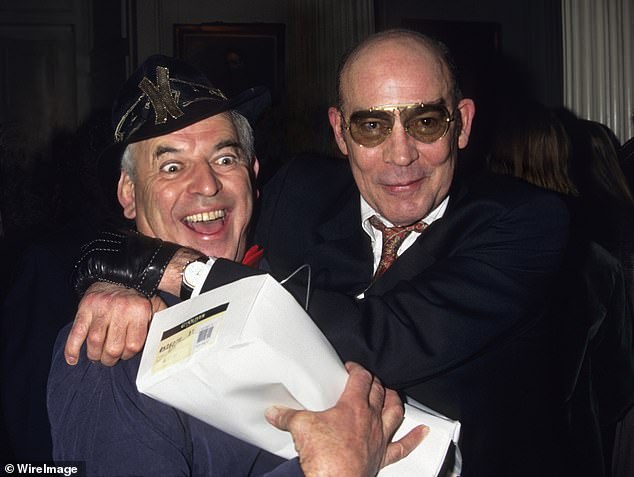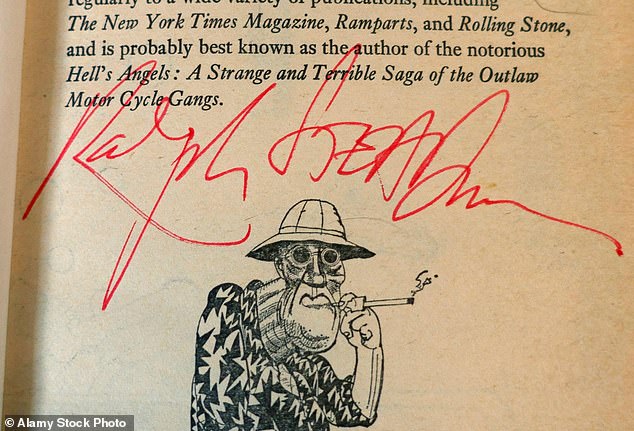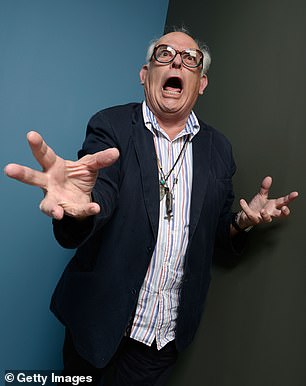Inimitable style: Ralph Steadman made his name at Punch and Private Eye
British satirical illustrator and cartoonist Ralph Steadman, 88, made his name in publications such as Punch and Private Eye before teaming up with American writer and journalist Hunter S. Thompson, says Dan Moore.
They met in 1970 when the pair covered the Kentucky Derby for Scanlan’s Monthly, and their later collaborations included the cult classic novel Fear And Loathing in Las Vegas: A Savage Journey To The Heart Of The American Dream.
With his inimitable scattered style of ink splatters and grotesque characterizations, Ralph has been in high demand for work ever since.
He has appeared on album covers by The Who and Frank Zappa, in novels such as Alice in Wonderland and Animal Farm, and in works by Ted Hughes and Brian Patten.
Father-of-five Ralph lives near Tenterden in Kent in the family home he shared with his late wife Anna.
What did your parents teach you about money?
I was taught to be honest, to be direct and to do the right thing. This included recording everything correctly so that the authorities know everything there is to know about you as a UK citizen.
What was your first job?
In 1952, before I did my national service, I worked as an apprentice radar operator at the De Havilland Aircraft Company in Broughton, Chester. I probably earned about 30 shillings a year.
How did you get into art?
I saw an advert for the Percy V Bradshaw Press School of Art course in Forest Hill, London. It said: ‘You too can learn to draw and gain pounds’. When I met Mr Bradshaw I told him the course was old-fashioned. He said: ‘Ah, lad, the rules of drawing never change’. We got on well. The principles of drawing are the same. People like Picasso changed it in some ways by making drawing into something a child can do but still ingenious.
When did you realize you could make a career out of it?
I don’t think I ever did. I feel as poor now as I did back then. I didn’t even consider drawing as a career, I was just trying to do it. I didn’t think I could make much money out of it, I just wanted to do it as well as I could and say something with it.
How did working with Thompson come about?
I was in New York. It was my first trip to the United States, in 1970, and JC Suarez, the design consultant for Scanlan’s Monthly, a counterculture magazine, asked me if I would like to go to Kentucky to cover the Derby with a former Hell’s Angel, a certain Hunter S. Thompson, who would write the article that I would illustrate.
I went in not really knowing what to expect. It took us days to meet up, and when we did, Hunter’s first comment was, “Well, they said you’d be weird, but not that weird.”
At the time I had a goatee and it wasn’t very common in Kentucky, but we brought out something that each of us had to release.
We had adventures, but they were very spontaneous. You never knew exactly what would happen with Hunter.

Dangerous Money: Ralph with American writer and journalist Hunter S. Thompson
Were you paid well for illustrating your writings?
An honest day’s work for an honest day’s pay was really all we wanted, and Jann Wenner, the editor of Rolling Stone, paid us well, as did Scanlan.
My daughter Sadie recently found the original Rolling Stone letters about the Fear and Loathing in Las Vegas assignment. It says, “We could pay you $500 for this job and we would guarantee you hospital care if you needed it during the course of this assignment.”
That sum rose to $750 when they increased the number of cover illustrations to ten pages with three spot drawings.
Do you have any regrets about selling your work?
Since I sold the original Fear And Loathing In Las Vegas to Rolling Stone founder Jann Wenner for $75, I have not sold most of my originals. I am often quoted as saying, “If anyone owns a Steadman original, it’s stolen.”
What was the best year of your financial life?
I probably worked for Oddbins Wine Merchants from 1987 for 12 years, and then when we signed with Flying Dog Brewery in 1995.
Commercial work is often the most lucrative. It allows me to fund projects I am passionate about, such as my children’s books, I, Leonardo or The Big I Am.
Have you ever been paid a ridiculous amount of money for a single job?
For one job I was paid for a brand new Golf Mark 1 Convertible. It had an A registration plate, so it must have been from 1983, when they cost £6,500 new.

Picture Perfect: Ralph’s work has been in high demand and has appeared on album covers and novels.
Are you a spender or a saver?
I am a saver. I was brought up to be careful and I have a pension.
What is your biggest whim?
In 1985 we installed a swimming pool in our house. I use it every day, so each swim costs me less and less.
What has been your best financial decision?
It was probably the purchase of our house, which is a Georgian mansion. It is a wonderful place and the whole family has enjoyed it over the years.
What financial advice have you given your children?
Just be careful, be honest and not be a scammer or cheater.
What’s ahead for you?
In September we will have an exhibition in Chatham called INKling.
Sadie has been organizing all of this. It’s been quite a task.
And that’s something I’ve always told my kids: commit 100 percent to whatever job you take on, don’t just do it for the money.
- Ralph Steadman: INKling runs from 21 September to 17 November at the Historic Dockyard Chatham (thedockyard.co.uk).
Some links in this article may be affiliate links. If you click on them we may earn a small commission. This helps us fund This Is Money and keep it free to use. We do not write articles to promote products. We do not allow any commercial relationships to affect our editorial independence.

